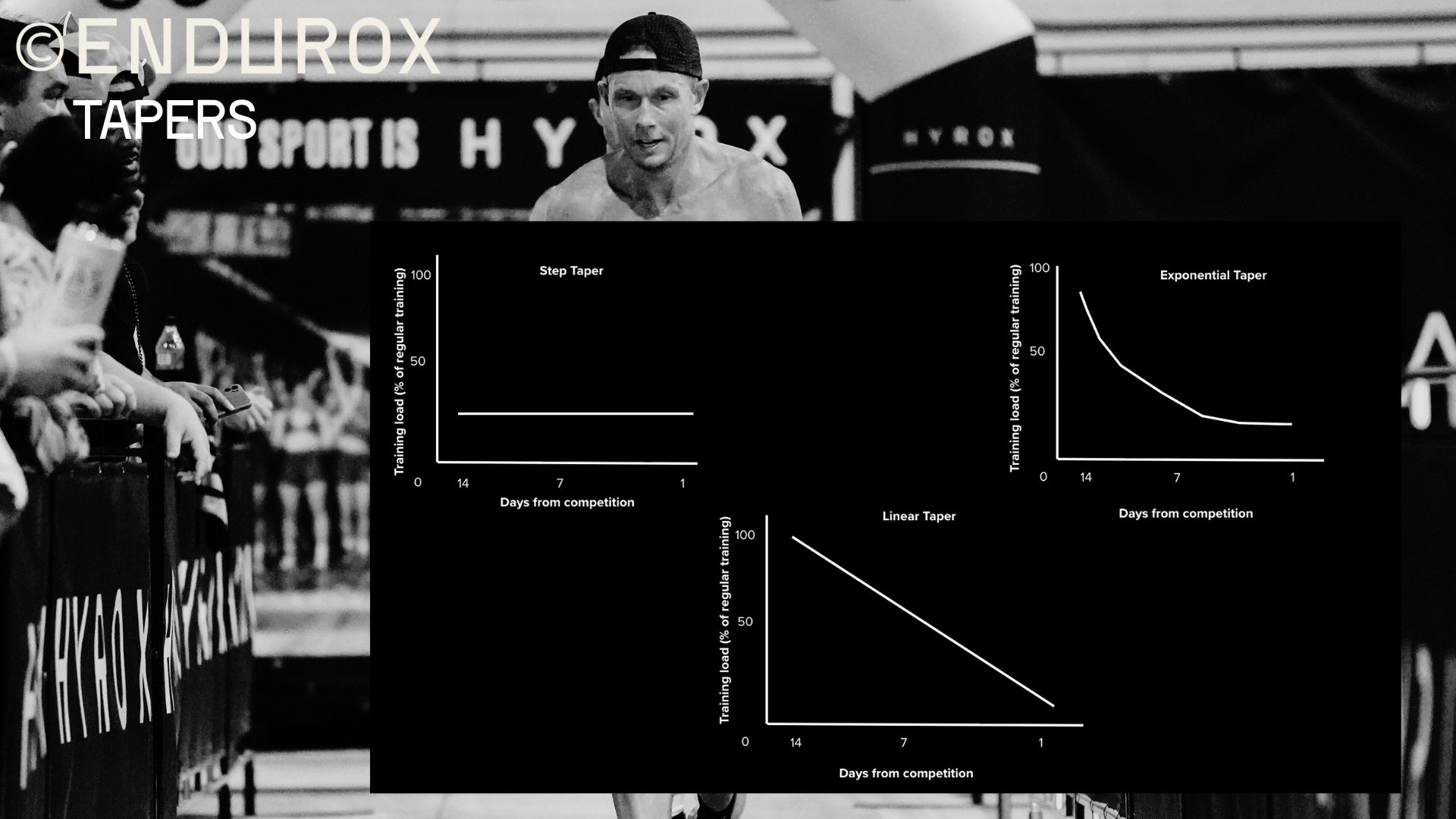The pre-competition taper is one of the most critical components of any HYROX build-up. Whether you're targeting a personal best or racing at the elite level, knowing how to taper effectively can make all the difference on race day.
In this blog, we break down the science and application of tapering for HYROX, with a focus on how to balance both strength and endurance systems, and ensure you arrive on the start line in peak condition.
Why Taper Before HYROX?
To taper effectively, it’s important to understand what a taper is designed to do. Tapering is the deliberate reduction in training load in the days leading up to competition (4). Its primary goal is to allow the athlete enough rest and recovery to perform at their best—without losing the fitness and adaptations gained through training (6).
In a HYROX context, this balancing act is especially nuanced. We need to manage accumulated fatigue from both endurance and strength-based sessions, while avoiding detraining in either system.
Research shows tapering is consistently beneficial for endurance performance (1, 5), which is crucial given the race's demand for sustained aerobic power across running and machine efforts. But we also need to maintain strength and neuromuscular readiness for heavy sleds, wall balls, and lunges. After all, the taper isn't about full rest—it's about smart adjustment.
KeyPrinciples for a HYROX Taper
When designing your taper, keep in mind several critical variables:
- Specificity: Are you preparing for a HYROX Open, Pro, or Doubles? Each has slightly different muscular demands and energy system contributions, this should be reflected in you training and as such, the taper should follow a similar rythem.
- The tapering model: Step, Exponential or Linear? See Figure 1. The research show, neither model is superior. This should be based on personal preference.
- Taper length: Most effective tapers range from 8–14 days (1), but duration may differ depending on the athlete's load and recovery capacity.
- Training adjustments: During taper, adjust:
- Volume: Reduce by ~40–60% (1, 5)
- Intensity: Maintain the same training intensity as you did during your build (1, 2, 5)
- Frequency: Aim to maintain usual session rhythm to avoid losing sharpness (1, 3)
For HYROX athletes, this might mean:
- Cutting back on running volume while still hitting key race-pace or threshold intervals.
- Reducing overall strength training sets but maintaining heavy loads to retain neuromuscular activation.
- Shorter, sharper station focussed circuits to maintain movement economy, technique and muscle coordination.

Endurance vs. Strength in the HYROX Taper
Unlike pure endurance or strength sports,HYROX sits in the hybrid space:
- Endurance elements (e.g., running, rowing, SkiErg) rely on fatigue reduction and VO₂ efficiency. Tapering helps unload accumulated fatigue while preserving aerobic fitness.
- Strength elements (e.g., sled push/pull, lunges, wall balls) require neural freshness and maximal voluntary contraction capacity. These qualities rebound more quickly and can be maintained with lower frequency but similar intensity.
IndividualisingYour Taper
As with most things in training, individual context matters. An athlete with high training volume might need a longer taper to freshen up. On the other hand, someone who’s had interrupted training(travel, illness, work stress) may benefit from a shorter, less aggressive taper.
Personal preferences, historical responses, and readiness markers (HRV, RPE, sleep) should all inform your taper design.
In Summary:HYROX Taper Checklist
- Reduce volume (by 40–60%)
- Maintain intensity.
- Preserve frequency, especially for movement patterns and technical elements.
- Adjust taper length based on individual needs (typically 8–14 days)
- Differentiate taper strategies for endurance vs strength
References
- Bosquet L, Montpetit J, Arvisais D, Mujika I. Effects of tapering on performance: A meta-analysis. Med Sci Sports Exerc 39: 1358–1365, 2007. doi: 10.1249/mss.0b013e31806010e0.
- Mujika I. Intense training: The key to optimal performance before and during the taper. Scand J Med Sci Sport 20: 24–31, 2010. doi:10.1111/j.1600-0838.2010.01189.x.
- Mujika I, Goya A, Ruiz E, Grijalba A, Santisteban J, Padilla S. Physiological and performance responses to a 6-day taper in middle-distance runners: Influence of training frequency. Int J Sports Med 23: 367–373, 2002. doi: 10.1055/s-2002-33146.
- Mujika I, Padilla S. Scientific bases for precompetition tapering strategies. Med Sci Sports Exerc 35: 1182–1187, 2003. doi: 10.1249/01.MSS.0000074448.73931.11.
- Neary JP, Martin TP, Quinney HA. Effects of taper on endurance cycling capacity and single muscle fiber properties. Med Sci Sports Exerc 35: 1875–1881, 2003. doi: 10.1249/01.MSS.0000093617.28237.20.
- Neary JP, Martin TP, Reid DC, Burnham R, Quinney HA. The effects of a reduced exercise duration taper programme on performance and muscle enzymes of endurance cyclists. Eur J Appl Physiol 65: 30–36, 1992. doi:10.5005/jp/books/12678_10.




.png)
.png)
.png)
